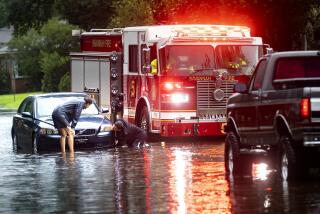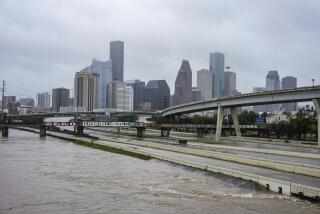A Soggy Southern Summer
HOUSTON — Summers here tend to be remembered as long, uninterrupted hot spells. But in Texas and across the Southeast, June was a soggy exception: An unexpected wave of rains came and lingered, flooding waterways, threatening wildlife and soaking crops that are still struggling to survive.
Even farmers, who worried about drought conditions in May, have had their fill.
“All this rain, I’ve never seen anything like it. It’s past ridiculous,” said Johnny Little, a third-generation Mississippi cotton grower. “I’ve put a bunch of money into this thing, and I can’t quit. I’ve got to try to salvage what I can.”
Weather systems that stalled over the Southeast and the Gulf of Mexico led to June rainfall totals were triple normal amounts in some parts of the South. Mississippi had a record 9.8 inches, compared with an average of 3.35 inches. Texas and Louisiana recorded their third-wettest June, with Houston getting 18 inches of rain and New Orleans 13.6.
The rain continued to fall this week in Mississippi but eased enough for Little to inspect the cotton and soybeans at his farm in Holcomb, in the northwestern part of the state. Narrow trenches dug to drain water have turned into gullies, he said. The sodden cotton isn’t growing as it should and the blooms are falling off.
“Last year’s crop was the best I had in my life. And before it started raining, it looked like it was going to be as good or better than last year. Now I don’t know what will happen,” said Little, 48.
Barring further gully washers, farmers will know in two to four weeks if their crops can be saved, said Steve Winters, director of the Mississippi state extension service in Grenada County. As much as 60% of the cotton and soybean crops in the county could be lost, he said. Ten percent already are ruined.
“Whether the other crops recover or not, the weather is going to play a critical role from here on out,” Winters said.
Elsewhere in the South, more than a month of steady rain brought flash floods and widespread power outages. In Texas, at least three people died in storm-related accidents. The Six Flags Over Texas amusement park shut down for a day after a creek overflowed. Standing water has become a breeding ground for mosquitoes -- and potentially for West Nile disease -- prompting officials to ask residents to empty birdbaths and flower pots
In New Orleans, mushrooms sprouted in street medians and birds swam in a makeshift pond that was once dry land in a city park. Worried farmers in Louisiana are working to save saturated fields of sugar and cotton, and state officials predict mass fish kills as the runoff from heavy rains contaminates freshwater fisheries.
In downtown Meridian, Miss., downpours were so fierce and sudden that firemen had to rescue residents from their cars in waters that rose to 4 or 5 feet, said Clarence Butler, director of emergency management. A recent storm flooded streets in a matter of minutes, and windshield wipers were useless against the onslaught. Then, just as suddenly, it was over.
“It’s been a strange summer,” Butler said.
Before the rains, states from South Carolina to Louisiana were listed as “abnormally dry” by the National Drought Mitigation Center; most of Georgia and parts of South Carolina and Florida were in a “moderate drought.” Now central Georgia -- which had an 8-inch rain deficit in May -- is a verdant green, said Pam Knox, Georgia’s assistant state climatologist.
Although more rain wouldn’t hurt, “it’s a balancing act,” Knox said. “Too much rain and farmers can’t get out into the field and you have mold and pest problems. But we don’t want the rain to shut off. We just want it to go back to more typical conditions.”
At the Southern regional climate center at Louisiana State University, state climatologist Barry Keim said the July forecast called for average rainfall amounts throughout the region. “Nothing out there indicates things will be abnormal,” he said. “But, of course, there wasn’t any indication there would be anything unusual in June, either.”
That’s not much comfort to Little, who was driven indoors several times this week by afternoon showers that seemed to pop up out of nowhere. In the last month, Little figures, he has worked in the field five days.
“The rest of time, it’s just sitting and wringing your hands. I don’t know how much more of this I can stand.”
*
Hart reported from Houston and Barry from Atlanta.
More to Read
Sign up for Essential California
The most important California stories and recommendations in your inbox every morning.
You may occasionally receive promotional content from the Los Angeles Times.










